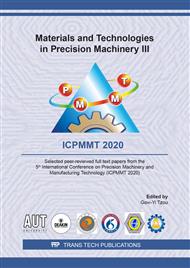p.27
p.33
p.41
p.48
p.56
p.64
p.74
p.80
p.88
Study on Mold Flow Analysis and Injection Product Verification by Analysis of Variance and Response Surface Method - Taking Toothbrush as an Example
Abstract:
With the advancement of technology, plastic products are inseparable in our environment, and the impact of the plastics industry on us is gradually increasing. Although Taiwan's plastics industry has been progressively added to mold flow analysis and automation, there are still some areas in the manufacturing process that can be optimized. In the process of slit-shaped materials, bending and deformation have a very large impact on the finished product, which is a major issue at the technical level. In this study, a toothbrush was taken as an example to find the best combination of injection molding parameters. The research process was studied from CAD mold design, CAE mold flow analysis, injection molding parameter analysis, mold opening, product injection and measurement, and the results were verified. Among them, the injection pressure, dwell time and holding pressure are used as the Taguchi factor, and the CAE mold flow analysis is performed by the direct cross table L16 (45) combination to find a small amount of warpage, and the Taguchi method and the reaction surface method are used to find out the best combination of parameters. After the final product was shot and the dimensions and simulation were compared with each other, the data showed that the amount of warpage of the finished product was 0.0892 mm, and the error with the analog value was 0.0212 mm, which confirmed that the injection molding parameters were reliable.
Info:
Periodical:
Pages:
64-73
Citation:
Online since:
October 2020
Authors:
Price:
Сopyright:
© 2020 Trans Tech Publications Ltd. All Rights Reserved
Share:
Citation:


